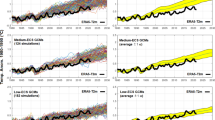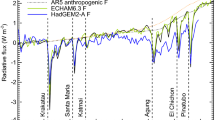Abstract
An intercomparison of eight climate simulations, each driven with estimated natural and anthropogenic forcings for the last millennium, indicates that the so-called “Erik” simulation of the ECHO-G coupled ocean-atmosphere climate model exhibits atypical behaviour. The ECHO-G simulation has a much stronger cooling trend from 1000 to 1700 and a higher rate of warming since 1800 than the other simulations, with the result that the overall amplitude of millennial-scale temperature variations in the ECHO-G simulation is much greater than in the other models. The MAGICC (Model for the Assessment of Greenhouse-gas-Induced Climate Change) simple climate model is used to investigate possible causes of this atypical behaviour. It is shown that disequilibrium in the initial conditions probably contributes spuriously to the cooling trend in the early centuries of the simulation, and that the omission of tropospheric sulphate aerosol forcing is the likely explanation for the anomalously large recent warming. The simple climate model results are used to adjust the ECHO-G Erik simulation to mitigate these effects, which brings the simulation into better agreement with the other seven models considered here and greatly reduces the overall range of temperature variations during the last millennium simulated by ECHO-G. Smaller inter-model differences remain which can probably be explained by a combination of the particular forcing histories and model sensitivities of each experiment. These have not been investigated here, though we have diagnosed the effective climate sensitivity of ECHO-G to be 2.39±0.11 K for a doubling of CO2.






Similar content being viewed by others
References
Bauer E, Claussen M, Brovkin V, Huenerbein A (2003) Assessing climate forcings of the Earth system for the past millennium. Geophys Res Lett 30:1276
Bertrand C, Loutre MF, Crucifix M, Berger A (2002) Climate of the last millennium: a sensitivity study. Tellus A 54:221–244
Crowley TJ (2000) Causes of climate change over the past 1000 years. Science 289:270–277
Crowley TJ, Baum SK, Kim KY, Hegerl GC, Hyde WT (2003) Modeling ocean heat content changes during the last millennium. Geophys Res Lett 30:1932
Cubasch U, Meehl GA, Boer GJ, Stouffer RJ, Dix M, Noda A, Senior CA, Raper S, Yap KS (2001) Projections of future climate change. In: Houghton JT, Ding Y, Griggs DJ, Noguer M, van der Linden PJ, Dai X, Maskell K, Johnson CA (eds) Climate change 2001: the scientific basis (contribution of WG1 to the third assessment report of the IPCC). Cambridge University Press, Cambridge, pp. 525–582
Foukal P, North G, Wigley T (2004) A stellar view on solar variations and climate. Science 306:68–69
Free M, Robock A (1999) Global warming in the context of the little ice age. J Geophys Res 104:19057–19070
Gerber S, Joos F, Brugger P, Stocker TF, Mann ME, Sitch S, Scholze M (2003) Constraining temperature variations over the last millennium by comparing simulated and observed atmospheric CO2. Clim Dyn 20:281–299
Gonzalez-Rouco F, von Storch H, Zorita E (2003) Deep soil temperature as proxy for surface air-temperature in a coupled model simulation of the last thousand years. Geophys Res Lett 30:2116
Goosse H, Crowley TJ, Zorita E, Ammann CM, Renssen H, Driesschaert E (2005) Modelling the climate of the last millennium: what causes the differences between simulations? Geophys Res Lett 32:L06710
Gregory JM, Ingram WJ, Palmer MA, Jones GS, Stott PA, Thorpe RB, Lowe JA, Johns TC, Williams KD (2004) A new method for diagnosing radiative forcing and climate sensitivity. Geophys Res Lett 31:L03205
Hansen J, Sato M, Ruedy R (1997) Radiative forcing and climate response. J Geophys Res 102:6831–6864
Harvey D, Gregory J, Hoffert M, Jain A, Lal M, Leemans R, Raper S, Wigley T, de Wolde J (1997) An introduction to simple climate models used in the IPCC second assessment report (IPCC technical paper II). IPCC, Geneva, 59 PP
Hirsch RM, Gilroy EJ (1984) Methods of fitting a straight line to data: examples in water resources. Water Resour Bull 20:705–711
Jones PD, Mann ME (2004) Climate over past millennia. Rev Geophys 42:RG2002
Kattenberg A, Giorgi F, Grassl H, Meehl GA, Mitchell JFB, Stouffer RJ, Tokioka T, Weaver AJ, Wigley TML (1996) Climate models—projections of future climate. In: Houghton JT, Meira Filho LG, Callander BA, Harris N, Kattenberg A, Maskell K (eds) Climate change 1995: the science of climate change (contribution of WG1 to the second assessment report of the IPCC). Cambridge University Press, Cambridge, pp. 285–357
Kheshgi HS, Jain AK (2003) Projecting future climate change: implications of carbon cycle model intercomparisons. Global Biogeochem Cycles 17:1047
Lean J, Beer J, Bradley R (1995) Reconstructions of solar irradiance since 1610—implications for climate change. Geophys Res Lett 22:3195–3198
Legutke S, Voss R (1999) ECHO-G, the Hamburg atmosphere-ocean coupled circulation model. DKRZ technical report, 18, DKRZ, Hamburg
Mann ME, Jones PD (2003) Global surface temperatures over the past two millennia. Geophys Res Lett 30:1820
Mann ME, Rutherford S, Wahl E, Ammann C (2005) Testing the fidelity of methods used in proxy-based reconstructions of past climate. J Clim 18:4097–4107
Moberg A, Sonechkin DM, Holmgren K, Datsenko NM, Karlen W (2005) Highly variable Northern Hemisphere temperatures reconstructed from low- and high-resolution proxy data. Nature 433:613–617
Murphy JM (1995) Transient-response of the Hadley Center coupled ocean-atmosphere model to increasing carbon-dioxide. 3. Analysis of global-mean response using simple-models. J Clim 8:496–514
Osborn TJ, Briffa KR (2004) The real color of climate change? Science 306:621–622
Ramaswamy V, Boucher O, Haigh J, Hauglustaine D, Haywood J, Myhre G, Nakajima T, Shi GY, Solomon S (2001) Radiative forcing of climate change. In: Houghton JT, Ding Y, Griggs DJ, Noguer M, van der Linden PJ, Dai X, Maskell K, Johnson CA (eds) Climate change 2001: the scientific basis (contribution of WG1 to the third assessment report of the IPCC). Cambridge University Press, Cambridge, pp. 349–416
Raper SCB (2004) Interpretation of model results that show changes in the effective climate sensitivity with time. Workshop on climate sensitivity, Paris, France, 26–29 July 2004. IPCC working group 1 technical support unit, Boulder, pp. 131–133
Raper SCB, Cubasch U (1996) Emulation of the results from a coupled general circulation model using a simple climate model. Geophys Res Lett 23:1107–1110
Raper SCB, Gregory JM, Osborn TJ (2001) Use of an upwelling-diffusion energy balance climate model to simulate and diagnose A/OGCM results. Clim Dyn 17:601–613
von Storch H, Zorita E, Jones JM, Dimitriev Y, Gonzalez-Rouco F, Tett SFB (2004) Reconstructing past climate from noisy data. Science 306:679–682
Widmann M, Tett SFB (2003) Simulating the climate of the last millennium. PAGES Newsletter 11(2/3):21–23
Wigley TML, Raper SCB (1991) Internally generated natural variability of global-mean temperatures. In: Schlesinger M (ed) Greenhouse-gas-induced climatic change: a critical appraisal of simulations and observations. Elsevier Science Publishers, Amsterdam, pp. 471–482
Wigley TML, Raper SCB (1992) Implications for climate and sea-level of revised IPCC emissions scenarios. Nature 357:293–300
Wigley TML, Raper SCB (2001) Interpretation of high projections for global-mean warming. Science 293:451–454
Wigley TML, Raper SCB (2002) Reasons for larger warming projections in the IPCC third assessment report. J Clim 15:2945–2952
Wigley TML, Ammann CM, Santer BD, Raper SCB (2005) Effect of climate sensitivity on the response to volcanic forcing. J Geophys Res 110:D09107
Yohe G, Andronova N, Schlesinger M (2004) Climate—to hedge or not against an uncertain climate. Science 306:416–417
Zorita E, Gonzalez-Rouco F, Legutke S (2003) Testing the Mann et al. (1998) approach to paleoclimate reconstructions in the context of a 1000-yr control simulation with the ECHO-G coupled climate model. J Clim 16:1378–1390
Acknowledgements
This research was supported by the European Community under Research Contract EVK2-CT2002-00160 SOAP. Grateful acknowledgement is given to Eduardo Zorita and Fidel Gonzalez-Rouco for allowing access to the ECHO-G model data, to Julie Jones for providing the data, to Tom Wigley for information about anthropogenic forcing time series, and to two anonymous reviewers for their constructive comments.
Author information
Authors and Affiliations
Corresponding author
Rights and permissions
About this article
Cite this article
Osborn, T.J., Raper, S.C.B. & Briffa, K.R. Simulated climate change during the last 1,000 years: comparing the ECHO-G general circulation model with the MAGICC simple climate model. Clim Dyn 27, 185–197 (2006). https://doi.org/10.1007/s00382-006-0129-5
Received:
Accepted:
Published:
Issue Date:
DOI: https://doi.org/10.1007/s00382-006-0129-5




